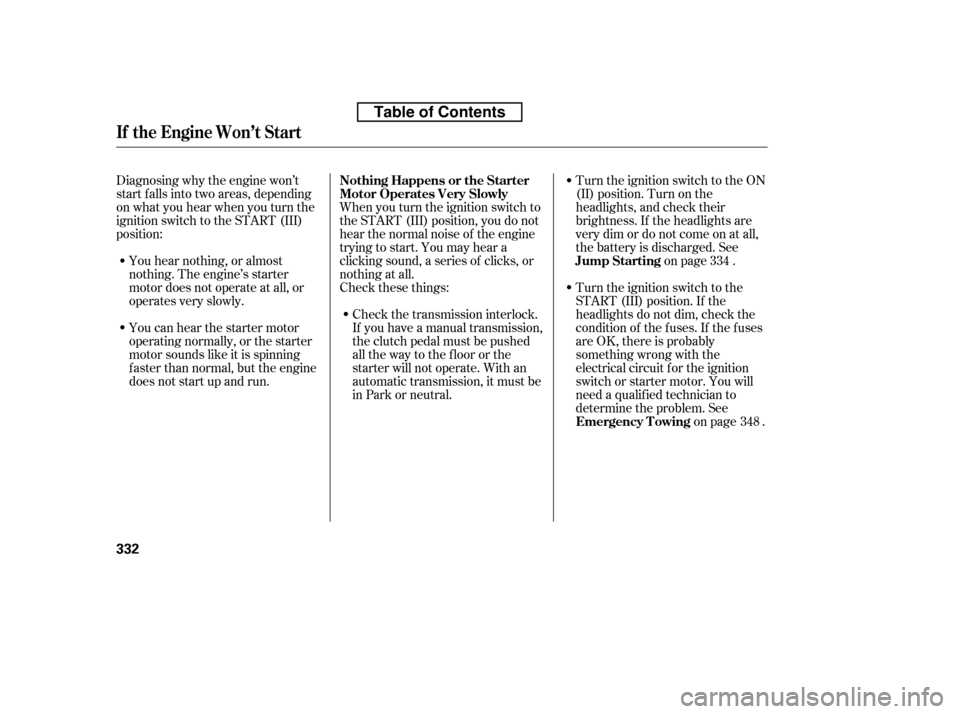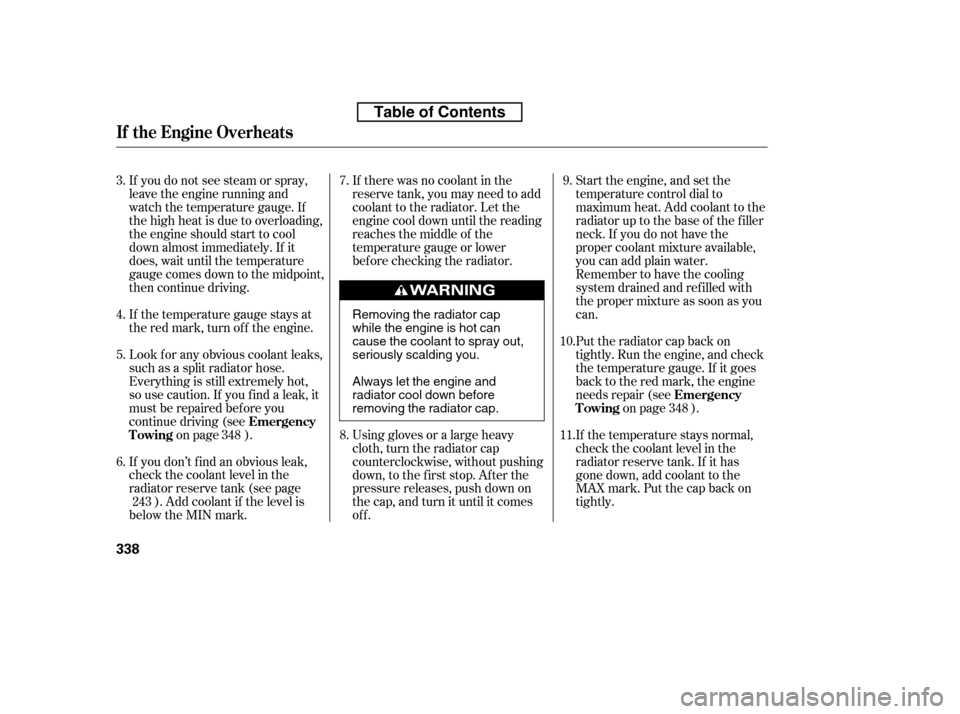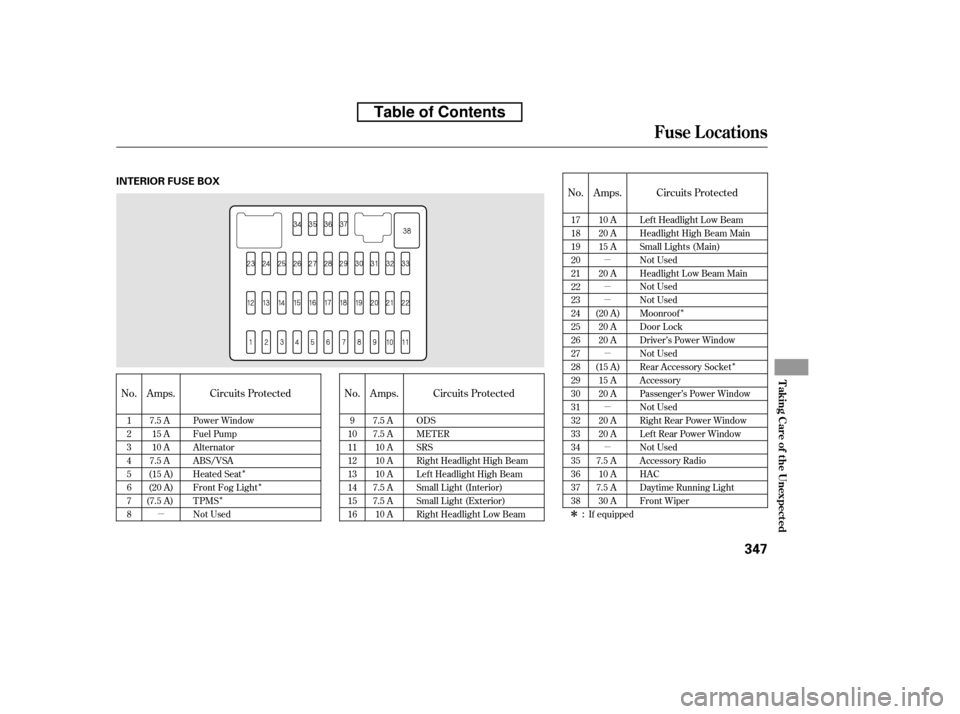Page 346 of 387

Diagnosing why the engine won’t
start f alls into two areas, depending
on what you hear when you turn the
ignition switch to the START (III)
position:You hear nothing, or almost
nothing. The engine’s starter
motor does not operate at all, or
operates very slowly.
You can hear the starter motor
operating normally, or the starter
motor sounds like it is spinning
f aster than normal, but the engine
does not start up and run. When you turn the ignition switch to
the START (III) position, you do not
hear the normal noise of the engine
trying to start. You may hear a
clicking sound, a series of clicks, or
nothing at all.
Check these things:
Check the transmission interlock.
If you have a manual transmission,
the clutch pedal must be pushed
all the way to the f loor or the
starter will not operate. With an
automatic transmission, it must be
in Park or neutral. Turn the ignition switch to the ON
(II) position. Turn on the
headlights, and check their
brightness. If the headlights are
very dim or do not come on at all,
the battery is discharged. See
on page .
Turn the ignition switch to the
START (III) position. If the
headlights do not dim, check the
condition of the f uses. If the f uses
areOK,thereisprobably
something wrong with the
electrical circuit f or the ignition
switch or starter motor. You will
need a qualif ied technician to
determine the problem. See on page .334
348
Nothing Happens or the Starter
Motor Operates Very Slowly
Jump Starting
Emergency T owing
If theEngineWon’tStart
332
Table of Contents
Page 352 of 387

Put the radiator cap back on
tightly. Run the engine, and check
the temperature gauge. If it goes
back to the red mark, the engine
needs repair (seeon page ).
If you do not see steam or spray,
leave the engine running and
watch the temperature gauge. If
the high heat is due to overloading,
the engine should start to cool
down almost immediately. If it
does, wait until the temperature
gauge comes down to the midpoint,
then continue driving.
If the temperature gauge stays at
the red mark, turn of f the engine.
Look f or any obvious coolant leaks,
such as a split radiator hose.
Everything is still extremely hot,
so use caution. If you f ind a leak, it
must be repaired bef ore you
continue driving (see
on page ).
If you don’t f ind an obvious leak,
check the coolant level in the
radiator reserve tank (see page ). Add coolant if the level is
below the MIN mark. Start the engine, and set the
temperature control dial to
maximum heat. Add coolant to the
radiator up to the base of the f iller
neck. If you do not have the
proper coolant mixture available,
you can add plain water.
Remember to have the cooling
system drained and ref illed with
the proper mixture as soon as you
can.
If the temperature stays normal,
check the coolant level in the
radiator reserve tank. If it has
gone down, add coolant to the
MAX mark. Put the cap back on
tightly.
Using gloves or a large heavy
cloth, turn the radiator cap
counterclockwise, without pushing
down, to the f irst stop. Af ter the
pressure releases, push down on
the cap, and turn it until it comes
off.
If there was no coolant in the
reserve tank, you may need to add
coolant to the radiator. Let the
engine cool down until the reading
reaches the middle of the
temperature gauge or lower
bef ore checking the radiator.
7. 8. 9.
3. 4. 5. 6. 10. 11.
348
243 348
Emergency
Towing
Emergency
Towing
If theEngineOverheats
338
Removing the radiator cap
while the engine is hot can
cause the coolant to spray out,
seriously scalding you.
Always let the engine and
radiator cool down before
removing the radiator cap.
Table of Contents
Page 357 of 387
Turn the ignition switch to the
LOCK (0) position. Make sure the
headlights and all other
accessories are of f .
Remove the cover f rom the f use
box.Check the smaller f uses in the
under-hood f use box and all the
fuses in the interior fuse box by
pulling out each one with the f use
pullerprovidedonthebackof the
under-hood f use box cover.
Check each of the large f uses in
the under-hood f use box by
looking through the top at the wire
inside. Removing these f uses
requires a Phillips-head screw-
driver.
1. 2. 3.
4.
CONT INUED
Fuses
T aking Care of t he Unexpect ed
343
FUSE PULLER
BLOWN
FUSE
BLOWN
Table of Contents
Page 359 of 387
When the audio system is disabled,
the clock setting in the audio system
will be canceled. You will need to
reset the clock (see page ).
If the radio f use is removed, the
audio system may disable itself . The
nexttimeyouturnontheradio,you
will see ‘‘ENTER CODE’’ in the
f requency display. Use the preset
buttons to enter the five-digit code
(see page ).
If the replacement fuse of the
same rating blows in a short time,
there is probably a serious
electrical problem with your
vehicle. Leave the blown fuse in
that circuit, and have your vehicle
checked by a qualif ied technician.
6.
206
207
Fuses
T aking Care of t he Unexpect ed
345
Replacing a f use with one that has a
higher rating greatly increases the
chances of damaging the electrical
system. If you do not have a
replacement f use with the proper rating
f or the circuit, install one with a lower
rating.
Table of Contents
Page 361 of 387

�µ�µ �µ �µ �µ�µ �µ
�Î
�Î
�Î �Î
�Î
�Î
No.
No.No.
Amps.
Amps. Circuits Protected Circuits Protected Amps. Circuits Protected
:
1 2345678 9
10111213141516 17181920212223242526272829303132333435363738
7.5 A
7.5 A
10 A
10 A
10 A
7.5 A
7.5 A 10 A
7.5 A
15 A
10 A
7.5 A
(15 A)
(20 A)
(7.5 A) Power Window
Fuel Pump
Alternator
ABS/VSA
Heated Seat
Front Fog Light
TPMS
Not Used ODS
MET ER
SRS
Right Headlight High Beam
Left Headlight High Beam
Small Light (Interior)
Small Light (Exterior)
Right Headlight Low Beam10 A
20 A
15 A
20 A
(20 A) 20 A
20 A
(15 A) 15 A
20 A
20 A
20 A
7.5 A 10 A
7.5 A 30 A Left Headlight Low Beam
Headlight High Beam Main
Small Lights (Main)
Not Used
Headlight Low Beam Main
Not Used
Not Used
Moonroof
Door Lock
Driver’s Power Window
Not Used
Rear Accessory Socket
Accessory
Passenger’s Power Window
Not Used
Right Rear Power Window
Lef t Rear Power Window
Not Used
Accessory Radio
HAC
Daytime Running Light
Front Wiper
If equipped
Fuse Locations
T aking Care of t he Unexpect ed
347
INTERIOR FUSE BOX
Table of Contents
Page 362 of 387

�µ�µ
If your vehicle needs to be towed,
call a prof essional towing service or
organization. Never tow your vehicle
with just a rope or chain. It is very
dangerous.
The operator
loads your vehicle on the back of a
truck.
Therearetwowaystotowyour
vehicle: If , due to damage, your vehicle must
be towed with the f ront wheels on
the ground, do this:
Release the parking brake.
Shif t the transmission to neutral.
Leave the ignition switch in the
ACCESSORY (I) position so the
steering wheel does not lock.
The tow
truck uses two pivoting arms that go
under the f ront tires and lif t them of f
the ground. The rear tires remain on
the ground. With the f ront wheels on the ground,
do not tow the vehicle more than 50
miles (80 km), and keep the speed
below35mph(55km/h).
Start the engine.
Press on the brake pedal. Move
the shif t lever through all its
positions.
Leave the ignition switch in the
ACCESSORY (I) position so the
steering wheel does not lock.
Release the parking brake.
Turn of f the engine.
Shif t to D position and hold f or 5
seconds, then to N.
Manual transmission:
Automatic transmission:
Flat -bed Equipment
Wheel-lif t Equipment
T his is the best way to
transport your vehicle.
This is an acceptable
way to tow your vehicle.
Emergency T owing
348
Improper towing preparation will
damage the transmission. Follow the
above procedure exactly. If you cannot
shif t the transmission or start the
engine (automatic transmission), your
vehicle must be transported with the
f ront wheels of f the ground.
Table of Contents
Page 363 of 387
Do not tie down the vehicle at an
angle that would allow the towing
cables to contact the vehicle’s f ront
bumper. To avoid possible damage,
protect the f ront bumper with tape.
If your vehicle is equipped with a
f ront spoiler, remove it bef ore
towing so it is not damaged.
Emergency T owing
T aking Care of t he Unexpect ed
349
The steering system can be damaged if
the steering wheel is locked. Leave the
ignition switch in the ACCESSORY (I)
position, and make sure the steering
wheel turns f reely bef ore you begin
towing.
Trying to lif t or tow your vehicle by the
bumpers will cause serious damage.
The bumpers are not designed to
support the vehicle’s weight.
Table of Contents
Page 366 of 387
The engine number is stamped into
the engine block. It is on the f ront.
The transmission number is on a
label on top of the transmission.
Identif ication Numbers
T echnical Inf ormation
353
MANUAL TRANSMISSION
NUMBER
ENGINE NUMBER
ENGINE NUMBER
AUTOMATIC/MANUAL
TRANSMISSION NUMBER
Except Si Si
Table of Contents